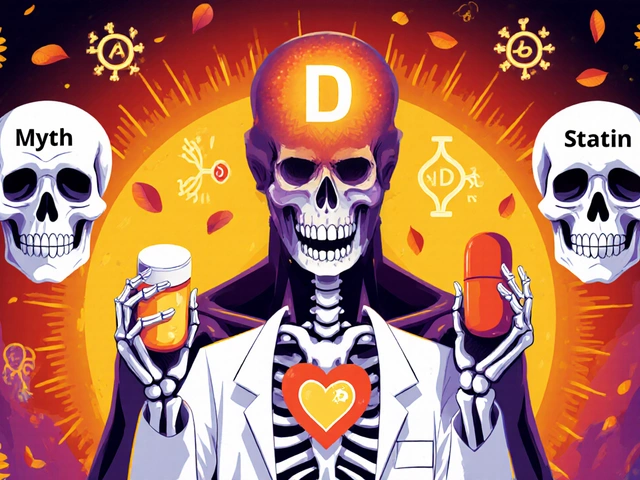Did you know that a drug initially designed for high blood pressure is now used for sleep issues, ADHD, opioid withdrawal, and more? Clonidine may sound like your average tablet on a pharmacy shelf, but it pops up in some pretty surprising places. People run into this medication from the doctor’s office, the rehab clinic, or even the school psychologist. But what is it really, and why do so many very different folks end up with clonidine in their hands?
How Clonidine Works and What It’s Used For
Clonidine is almost a Swiss army knife when it comes to medications. It started out as a treatment for high blood pressure back in the 1960s, approved by the FDA in 1974. Doctors soon noticed something interesting: the calming effects went beyond just lowering numbers on a blood pressure cuff. It tames the stress response in your nervous system, making it relevant for things like ADHD or opioid withdrawal. Here’s how clonidine pulls off these tricks:
- It stimulates so-called alpha-2 adrenergic receptors in your brain. In normal English, that means it dials down the "fight or flight" output, lowering heart rate, relaxing blood vessels, and settling your system.
- Lower stress signals mean less pounding in your chest, fewer shakes, and steadier thinking. That’s why some doctors use it for anxiety, insomnia, or even hot flashes.
The top uses for clonidine in the U.S. are:
- Treating high blood pressure (hypertension)
- Calming symptoms of ADHD, particularly in kids—and sometimes adults—who can’t tolerate stimulants or need extra help sleeping
- Managing withdrawal symptoms from opioids, nicotine, or even alcohol
- Tackling certain anxiety disorders, PTSD symptoms, and sleep disruptions—usually when other meds haven’t worked
- Less common: used to help with menopausal flushing or control migraine headaches
There’s real data backing up these uses. One clinical trial published by JAMA in 2011 found that clonidine, combined with buprenorphine, helped opioid-dependent patients get through withdrawal more comfortably and stick with treatment. The CDC reports clonidine prescriptions have climbed as doctors get creative for patients with complicated symptoms no one drug alone can fix.
Dosage, Brands, and How to Use Clonidine Safely
Clonidine comes in a bunch of forms: little white tablets, extended-release pills (great for ADHD), and skin patches for 24/7 blood pressure control. The dosing looks different depending on what you’re treating. Here’s the rundown:
- High blood pressure: Most adults start with 0.1 mg twice a day, adjusting by 0.1 mg as needed. Patches are changed weekly.
- ADHD (kids): Extended-release versions (like Kapvay) start at 0.1 mg at night, climbing up slowly, but rarely going above 0.4 mg a day.
- Withdrawal: Short-term regimens, tailored based on symptoms, with close monitoring in a clinic.
- Off-label uses (anxiety, sleep): Usually tiny doses, often just 0.1 mg at night.
Brands you’ll see in the pharmacy include Catapres (immediate release), Kapvay (extended release for ADHD), and generic versions just called clonidine. Never swap extended-release for immediate-release pills on your own—each works differently in your body.
Here are some pointers to stay out of trouble:
- If you miss a dose, take it as soon as you remember—but don’t double up if you’re close to your next one. Clonidine’s got a reputation for causing swings in blood pressure if you bounce around on dosing.
- Don’t stop clonidine suddenly. Your blood pressure could spike fast enough to cause headaches, tremors, or heart problems. Always taper off under a doctor’s guidance.
- Patches should be changed on a new, hairless area each week. If the patch falls off, stick on a new one and mark that date as your new change day.
- Keep clonidine safely away from kids and pets—an accidental dose can send blood pressure dangerously low or cause deep sedation.
Pairing clonidine with other sedatives, blood pressure drugs, or alcohol can make you dizzy, sleepy, or faint. Always let your doctor know what else you’re taking.
| Condition Treated | Form Used | Typical Dose Range | Notes |
|---|---|---|---|
| Hypertension | Tablet, Patch | 0.1–0.3 mg, 1–2x/day | Patch lasts 7 days |
| ADHD (children) | Extended-release tablet | 0.1–0.4 mg/day | Start low, go slow |
| Opioid withdrawal | Tablet | 0.1–0.3 mg every 6–8 hours | Short-term use |

Side Effects, Safety Concerns, and Real-World Tips
Clonidine makes some people sleepy—really sleepy. One survey of Seattle patients found about 35% described daytime drowsiness, and in kids, it’s even higher. Dry mouth is another biggie, followed by constipation, dizziness, headaches, or that "hungover" grog if you stand up too quickly. skin, rashes, or local irritation from a patch can happen too.
Less common but worth knowing about, clonidine can slow down your heart too much. This matters if you’ve got a pacemaker or a history of heart rhythm problems. Rarely, people might notice mood changes or confusion, especially if the dose is high or you mix it with other central nervous system meds.
- Drink lots of water and keep sugar-free candy handy for dry mouth.
- Get up from beds or couches slowly, especially if you’re new to clonidine.
- If the patch causes a skin rash, switch spots each time—and avoid the same patch spot twice in a row.
- Talk to your doc if you notice heart pounding, skipped beats, or weird palpitations—they may want an EKG before starting or during treatment.
- Store the patch out of sunlight and heat; high temps can dump suddenly too much medicine into your bloodstream, causing a dangerous drop in blood pressure.
- Older adults are at more risk for low blood pressure and falls. Extra caution for anyone over 65.
- Pharmacists in Seattle say about 15% of accidental overdoses come from kids finding unused patches, so always fold and flush (don’t toss!) used patches.
Withdrawal is no joke. Quit clonidine cold turkey, and you could wind up with rebound high blood pressure—way worse than where you started. If you need to stop, do it with a gradual taper, shaving off a small chunk every three days or longer. Some people notice vivid dreams or wild mood swings during withdrawal, so stay in close touch with your prescriber.
Here’s a tip for parents: if your kid is on clonidine for sleep or ADHD, timing is everything. Give the tablet about an hour before bedtime, and keep evening routines chill and screen-free to help the medicine work its magic.
Who Should (and Shouldn’t) Use Clonidine?
Clonidine shines for people who need something gentle, non-addictive, or who can’t tolerate traditional medication side effects. It’s one of the few non-stimulants kids with ADHD can use without risking dependency. Doctors often try it as a second-line, or sometimes third-line, treatment if others don’t cut it or cause crazy side effects.
But it isn’t for everyone. Anyone with a history of severe heart disease, recent heart attack, or certain arrhythmias should steer clear unless a specialist is involved. Pregnant and breastfeeding women should avoid it unless absolutely necessary, since it can cross the placenta and show up in breastmilk. People with severe kidney disease need much lower doses—clonidine leaves the body mainly through the kidneys, so if yours don’t work well, the medicine can build up and cause problems fast.
- Not sure if clonidine is right for you? People who struggle to swallow pills can try the patch. Kids who hate wearing patches or have sensitive skin may do better with liquid or crushed tablets.
- If you have uncontrolled depression or a history of low heart rate, bring it up with your doctor first—it can worsen both.
- Let every provider you see know if you’re taking clonidine. Emergency docs, dentists, even eye doctors (a surprising number of glaucoma drops interact with it) need to know for your safety.
Clonidine won’t fix all your symptoms instantly. Effects on anxiety or sleep usually show up after several days. For ADHD it might take weeks, with gentle tweaks in dosing along the way. Don’t give up too soon—or double your own dose if you feel nothing at first.
There’s a reason this humble little tablet refuses to leave the spotlight. Clonidine’s borrowed uses—from helping sleepless kids to smoothing out the wild ride of addiction withdrawal—mean it touches more lives than most folks realize. With careful dosing, respect for side effects, and some real-world tips, it can make tough problems just a little bit easier to handle.








12 Comments
Francisco Garcia July 18, 2025
This is a pretty comprehensive post about clonidine. I like how it touches on multiple conditions like high blood pressure, ADHD, and anxiety—those are really diverse uses for one medication.
One thing that caught my eye was the section about managing side effects. Sometimes these can be overlooked when people are just focused on the benefits, but getting a practical look at what to watch for really helps.
Does anyone have personal experience using clonidine for something like withdrawal symptoms? I'm curious about how effective it is compared to other treatments.
Also, I appreciate that the article offers real-world examples. That sort of insight is invaluable in understanding how the medication works outside of clinical trials.
Overall, I'd say this guide makes the info very accessible to anyone unfamiliar with clonidine but considering it as a treatment option.
KAYLEE MCDONALD July 20, 2025
I appreciate the straightforward nature of the post. Clonidine definitely needs to be handled with care given its side effects.
It's interesting how it covers anxiety and ADHD, which aren't common in the same breath as blood pressure meds. That mix can confuse some people about how to use it safely.
One thing I wish was emphasized more is how you should never stop clonidine abruptly. That can lead to rebounds with serious effects.
Does anyone else feel like more awareness needs to be raised about the withdrawal dangers? Because from experience, it’s no joke.
Alec McCoy July 21, 2025
Building off of those points, I feel it’s crucial that anyone taking clonidine has a healthcare provider closely monitoring them during the entire treatment course.
Whether it’s for ADHD symptoms or withdrawal, you need that constant feedback loop to adjust dosage or address side effects as they arise.
Too often people self-medicate or tweak doses without guidance, leading to worse outcomes.
And the multitasking nature of this drug means it impacts different systems—one dose doesn’t fit all scenarios.
Safe treatment hinges on awareness, honesty with your doctor, and patience during titration. I think this guide lays out foundational ideas nicely but everyone should seek professional advice.
Aaron Perez July 23, 2025
Ah yes, clonidine—the very embodiment of contradicting roles in medicine! It’s simultaneously a neuro-muscular pacifier and a cardiovascular disruptor. One must marvel at this molecular paradox it presents.
Do we truly understand all the ripple effects of such a compound in the labyrinth of human biochemistry?
Yet, here we are, lauding its virtues while wary of the dangers lurking in its side effect spectrum.
Shouldn’t we question further why pharmaceuticals like these exist in the first place—what does their prevalence say about our modern approach to health?
I posit that we often resort to such medications as a quick fix without delving into holistic health architectures.
Still, kudos to guides like these that educate responsibly.
Patrick Renneker July 24, 2025
Despite the evidently extensive nature of this guide, I must express a degree of skepticism regarding the practical application of clonidine in the outlined contexts.
While the author purports its utility in states as varied as anxiety, hypertension, and ADHD, the underlying pharmacodynamics suggest a rather indiscriminate mechanism of action that ought to prompt caution rather than enthusiasm.
Indeed, the side effect profile of this agent, which can include severe hypotension and bradycardia, mandates a level of medical oversight far beyond occasional check-ins.
Has there been sufficient longitudinal data to confirm long-term safety, especially in pediatric populations using clonidine for ADHD?
Further, the laudable intent to provide 'real-world examples' must be tempered by an acknowledgment that individual patient responses can vary dramatically.
In sum, while the article is informative, I urge readers to maintain a critical lens.
Michelle Weaver July 25, 2025
😊 This post does a great job breaking down lots of crucial info about clonidine! It’s so important to understand both benefits and risks when using medications.
In my experience, patients really appreciate practical tips on side effect management because it helps keep expectations realistic and reduces anxiety around treatment.
The mention of withdrawal symptoms monitoring is especially key, since tapering off clonidine improperly can be dangerous.
It might be helpful if future posts include some simple charts or dosage schedules for different uses of clonidine — visual aids always help comprehension!
Overall, thanks for shedding light on such a multi-purpose, yet often misunderstood medication! 👍
Evan Riley July 26, 2025
I can’t help but wonder if the widespread use of clonidine isn’t part of some bigger scheme to mask underlying systemic health failures.
Why push a drug that acts as a central nervous system depressant for so many conditions instead of addressing root causes?
Pharmaceutical agenda or not, the risks often outweigh the transient benefits in many scenarios I’ve seen.
Has anyone else caught whispers about off-label push pressures within the industry?
Not saying the drug doesn’t help, but let’s not have blind faith in pharma protocols.
Critical thinking and skepticism remain key.
Nicole Povelikin July 28, 2025
u guys r all missing somethng important here. clonidne isnt 4 everyone. its risky and some docs keep pushin it coz insurance covers it or its 'cheap' or whateva. like it can mess with ur blood pressure real bad if ur not watched.
idk why no1 talks about how some peeps get real tired n confused, its scary. also, side effects list is way longer tan ud think. pls b careful n dont just take on advice here.
did ppl here try natural stuff? or other meds without all this drama?
ask ur dr more than once and get others opinions too lol.
William Mack August 3, 2025
Thanks for sharing this detailed guide. The multipurpose use of clonidine really intrigued me, and I find it helpful that the article provides practical safety tips.
From my perspective, it’s essential to balance understanding the therapeutic potential while recognizing individual variability in response.
Has anyone encountered particularly unusual side effects or found effective coping strategies while on clonidine?
Also, I'd appreciate thoughts on how to best communicate with healthcare providers about adjusting dosage.
Deepak Bhatia August 10, 2025
This is a useful article for those using clonidine. As someone unfamiliar with this drug before, I found the explanations plain and helpful.
The part about treating withdrawal symptoms was new to me, which shows how versatile the drug is.
I wonder how it compares with similar medications in cost and effectiveness?
Good to know the side effects and safety measures so people can avoid surprises.
Samantha Gavrin August 16, 2025
I think it’s very naive to take this information at face value without questioning the motives behind pushing drugs like clonidine so widely.
Big Pharma’s influence here can’t be ignored, especially when safer, less addictive alternatives might exist but get overlooked.
Side effects are often minimized in official guides, leaving consumers ill-prepared for reality.
Reading this made me want to learn more about potential conflicts of interest involved in clinical trials and prescriptions.
Anyone else digging beyond the surface on clonidine's promotion?
Alec McCoy August 17, 2025
@Nicole, your point about insurance and prescription trends is really important. It’s frustrating how cost and coverage issues sometimes drive recommendations more than patient-specific factors.
And @Samantha, I agree that skepticism is healthy, but we shouldn’t dismiss clonidine outright. There are patients who truly benefit when used correctly.
What this all reminds me is the need for individualized care plans that incorporate patient education, continuous monitoring, and alternative options when appropriate.
Maybe future updates to articles like this could address those broader healthcare system issues, too.
How do you all feel about integrating patient advocacy in medication discussions?